Environmental Analysis and Estimation of Evaporation Rate using Pennman Numerical Simulation in the Salt Production Industry in Occidental Mindoro
Michelle Enriquez*
College Dean, Occidental Mindoro State College, Philippines
Submission: February 28, 2022; Published: April 08, 2022
*Corresponding author: Michelle Enriquez, College Dean, Occidental Mindoro State College, Labangan Poblacion, San Jose, Occidental Mindoro, Philippines
How to cite this article: Michelle E. Environmental Analysis and Estimation of Evaporation Rate using Pennman Numerical Simulation in the Salt Production Industry in Occidental Mindoro. The Case of Candanchú (Spain). Int J Environ Sci Nat Res. 2022; 30(2): 556282. DOI: 10.19080/IJESNR.2022.30.556282
Abstract
Salt or sodium chloride has been in use as a flavoring substance to improve the taste; or as preservatives for meat, fish and other food products. The salt production is considered as one of the oldest industry in the world ranging from the traditional solar evaporation to advanced technology-based harvesting method. Occidental Mindoro was once known in salt production industry contributing almost 18% of the country’s salt production. But the industry experienced losses, as climate change impacts continue to worsen the weather patterns. As the province is trying to reclaim its reputation in salt industry, salt farmers are continuously seeking ways on increasing their harvest and ensure production year-round and even during the off-season. Historical analysis is presented in this study to determine which among the physical, environmental/ecological and biological system has a great impact on the salt production, characterizing the processes in the solar production was presented to understand how each stages is affected by climatic patterns. Results of the study shows that meteorological factors like temperature, wind speed, atmospheric pressure, wind speed and humidity greatly affects the evaporation rate. Higher temperature, minimum wind speed, lower humidity and less rainfall increases the evaporation rate thus speeds up the evaporation process and produces more salt).
Keywords: Environmental analysis; Evaporation rate; Pennmann- Numerical solution; Salt production
Introduction
Salt is considered as one of the important economic mineral that is widely distributed on all the continents occurring in large reserves [1]. Salt production is one of the most ancient and widely distributed industries in the world where almost 120 countries have salt producing facilities ranging from primitive solar evaporation to advanced and multi stage [2]. The annual world production of salt can exceed to 200 million tons with more than one-third produced by solar evaporation of sea water and inland brines, and the rest by mining of rock salt [3].
Salt industry in the Philippines was once a vibrant industry. In 1990, the provinces of Bulacan, Pangasinan, Occidental Mindoro and Cavite supplied almost the 85% of the country’s annual salt requirement. In 1994, the country can still produce 300,000 metric tons of salt. But in 2010, salt production drastically dropped to less than half and significantly resulted to the importing of salt [4].
Occidental Mindoro was once one of the biggest salt producers in the country. In 1990, it produced and contributed about 60,000 metric tons of the 338,000MT or 18% of the country’s total salt production [5]. Today, while Occidental Mindoro still supplies salt in the neighbouring provinces in Southern Luzon, Visayas, and Mindanao, only 12 percent of the national salt requirement comes from the province with the biggest chunk of the demand supplied by imported salts.
The province, being an island and surrounded by water, has one of the longest coastline but is greatly affected by the climate change and decimated the salt industry. The traditional method of producing salt used in the province depends primarily on solar evaporation is affected adversely by erratic weather patterns. The physical and chemical composition of salt produced varies dependently in many factors: production techniques, processes and the climatic conditions. Salt production through solar production is mainly dependent on dry season.
As the province is trying to reclaim its reputation in salt industry, salt farmers are continuously seeking ways on increasing their harvest and ensure production year-round and even during the off-season. Seeing the potential of the salt industry to drive the local economy of the province, Occidental Mindoro Salt Council was created in 2018 which pieced together a roadmap for the Occidental Mindoro Salt industry with the end view of developing a salt industry that meets the domestic and international standards in order to provide equitable benefits by using socially responsible and environment-friendly practices. The roadmap envisioned that by 2022, the province of Occidental Mindoro shall be known as the Salt Capital of the Philippines producing high quality salt products at competitive prices for the domestic market catering to the consumers, food processors, industrial and agricultural users [6].
As climate pattern in the province changes in time, salt industry experiences fluctuation on the volume of salt produced affecting salt farmers and traders. Longer dry season increases the salt production while rainfall and continuous rain flooded the salt beds. The objective of this paper is to understand the salt production processes in the province through characterization of the physical and environmental factor and determine how climatic conditions affect the salt industry.
Historical analysis is presented in this study to determine which among the physical, environmental/ecological and biological system has a great impact on the salt production. This study aims to present the existing condition of salt industry in Occidental Mindoro using the data obtained in three weather stations: Barrio Site, Toong and Laste. Specifically, it aims to: characterize the physical and environment system of the salt farms; present the processes involved in salt production; determine the evaporation rate using the climatic characteristics identified in the three sites; and identify the evaporation rate in the salt production.
Methodology
Study area
In the three sites where salt farms and the weather stations are situated, salt beds are located adjacent to the coast, and salt beds are slight higher than the normal high water line. Sitio Toong and Laste are located in the municipality of Magsaysay, Occidental Mindoro, both facing the China Sea with vast plains and valleys. Slope ranges from level to very steep sloping areas; highest point of elevation is 543 ft. above sea level (Figure 1).
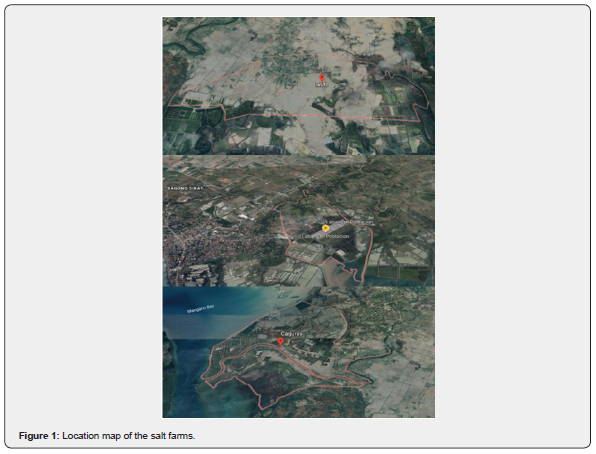
Laste is situated at approximately 12.253 lat and 121.1741 long with elevation of 2.7m or 8.9ft above mean sea level [7]. Salt beds can be seen approximately from 216.17m. While Sitio Toong is located in Brgy. Caguray, Magsaysay, Occidental Mindoro lying at 12.2828 lat and 121.1185 long with elevation estimated at 7.0m or 23.0 feet above mean sea level and with distance of approximately 552.72m from the coastline (PhilAtlas, 2019).
On the other hand, Sitio Barrio site, is situated in Labangan Poblacion, San Jose lying along at nearly 12.3582 lat and 121.0776 long, and elevation estimated at 9.9m or 32.5feet above mean sea level [8].
Pennman evaporation rate
To characterize the physical and environment system in thee three sites, an environmental scanning is conducted to determine the prevailing characteristics in the salt farms. Meteorological data from three (3) weather stations: Laste, Sition Toong and Barrio Site from January 16, 2019 to May 29, 2019 are used to estimate the evaporation rate on the salt farms.
A historical background in terms of annual volume of salt produced is presented as part of the site analysis. The method used including the preparation, harvesting and transportation of salt is further identified to describe the processed of salt production.
The climatic factors like proximity to sea water, elevation, soil type and other hydrological parameters were identified to determine the evaporation rate. Numerical Simulation using the Pennman equation as modified by [9] is used to determine the evaporation rate for the four-month period.

The evaporation rate is expressed in mm/day; λ is the latent heat of vaporization; Δ is the gradient of the vapor pressure-temperature curve; γ is the psychometric constant; Rn is the net solar radiation; f(u) is the function of wind speed’ es and e are the saturation vapor pressure of water and ambient water vapor pressure [10].
Results and Discussion
Management of salt production
Preparation of beds
Most of the salt farms in Occidental Mindoro are small scale. Estimated total salt farms in San Jose and Magsaysay, Occidental Mindoro is approximately 2,000 hectares. From this land areas, there are 35,544 estimated salt beds own and manage by almost 50 salt producers in the province [11].
The Tamaraw Salt Producers Cooperative [11] leads the salt production industry in the province of Occidental Mindoro. Salt farms are nearly located where salt water are accessible and can easily enter the salt beds. Areas with mudflats slightly above the high tidal range are leveled and compacted during the dry season. Each areas is divided into salt pans arranged as reservoir, condenser and crystallizer.
Salt farms are designed considering the natural characteristics of the selected site and prevailing climatic conditions. The salt farms are consists of shallow ponds ranging from 15-60cm supplied by the sea water stored in the reservoir. The shallow pond is divided into evaporation ponds where sea water is concentrated up to saturation until NaCl salinity is obtained. While, the crystallization ponds is where the salt crystallizes by evaporation of the brine up to 28-29°Be. The evaporation ponds constitute 90% of the production area and the remaining 10% used as crystallization ponds, where salt is harvested.
Stocking of seawater
Stocking of sea water in the reservoir is done through dikes connected to rivers or canals. The design of the salt pans considers the level of tide to ensure that sea water will flow freely through the gates of the reservoir. The seawater from the reservoir flows into the condenser pan. Then water flows through the inlet canal placed in the condenser to the crystallizer and only high saline water is transferred from condenser to the crystallizer, then the salt crystals start to form. The accumulation of salt increases by the rate of evaporation in the environment. It is continuously evaporated by solar heating and wind flow. As the water evaporates, the salinity rises and salt crystals formed. When the water dries up, the salt crystals are now ready to harvest by raking or sweeping.
Harvesting and production rate
Sea water is stored in the reservoir for almost 2 weeks, then evaporated off from the direct sunlight and let the remaining sea water dense with salt. The gate of the reservoir is then opened and allowed to flow in the salt beds. It is then dried up for more than 3 hours until salt crystals are seen in the surface. The salt crystals are harvested by raking or sweeping. Harvesting of salt is a difficult activity since it entails direct exposure to sun. From the salt farmers in the province, there are almost 4,035 regular salt farm workers harvesting the salt produced (TAMACO, 2019). Figure 2 shows the production rate from 2008 to 2017.
The figure shows that volume of salt in bags produced in the province increases from 2008 to 2011 reaching to more than 1,100,00 bags but an almost 20% sudden decreased was experienced in 2012; with a gradual increased from 2013 to 2016. Moreover, a recent data on the volume of salt produced in bags was obtained by the researcher during the 4-month period the same duration of the meteorological data obtained in the three sites. Table 1 shows the volume of salt produced based on the four-month period bags sold Salt Traders and TAMACO.
The table significantly shows that much of the salt production is bought by big traders and buyers and only small portion by TAMACO. As stated by the cooperative, it is because of the higher price that the traders offered for each bag of salt. And also one of the reason why the cooperative is appealing for establishing a fix price of salt per bag in the province.
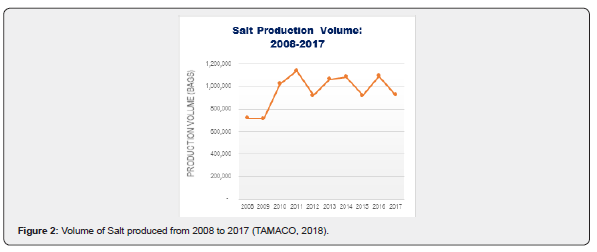

Transportation of salt
The salt harvested in each salt farms brought by Traders, other buyers and TAMACO are stored in salt warehouses and transported outside the province. A Salt Washer located in Mapaya, Magsaysay was owned and operated by TAMACO that can washed the raw salt to obtain a whiter salt granules free of dirt and other impurities. TAMACO allowed other salt farmers to use the salt washer to ensure that a cleaner salt is transported and delivered.
Marketing and the price fluctuation
Price of salt per bags is dominated by the presence of traders and other buyers in the province and seasonality. Prices offered by the traders is higher compared to that of the cooperative. Since most of the salt farmers are small scale, they opted to sell their harvest to traders while, during dry season prices of salt bags dropped and increases during off season. Salt producers having warehouses, stored their harvests and disposed when the price escalates. Figure 3 shows the summary of variation of prices during the 4month period of January to May, 2019
The figure shows that as dry season is experienced in the province, the price of the salt per bags drastically drops as low as 100 pesos. This can affects the small scale salt farmers’ operation cost. The cause of price variation may be attributed to the over production during dry season, dominance of middlemen or traders, the lack of government policy for fixed price rating and the lack of support to empower the salt farmer.
Factors affecting salt production
Environmental condition
A thorough environmental investigation is needed to assess the acceptability of a site for salt production. Assessment is barely based on the natural features of the surrounding environment. The salt farm areas in Occidental Mindoro are mainly found in the coastal wetlands. The availability and accessibility of salt water is first to consider in determining the viability for site production. Soil condition is also considers in the site selection as it affects the soil permeability that determines the capacity of the underlying soil to hold water. Seepage rate is also consider as it is dependent on the soil type and soil particle size. Soil type in the three sites are sandy clay and silty clay.
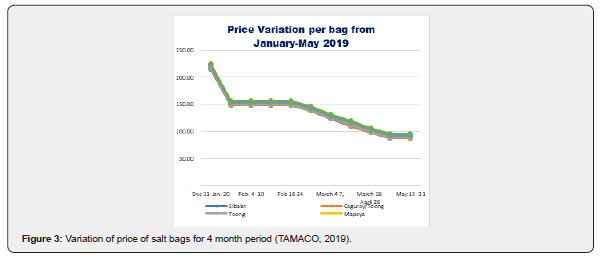
Seasonality
Climate plays an important role in sea salt production. The variation in rainfall patterns as affected by the climate change greatly affect the production rate of salt industry. The province’s erratic rainfall patterns causes flooding in the salt beds. Salt production process was then affected as sea beds were inundated by water. Moreover, temperature also affects the salt production; the higher the temperature, the more salt can be produced. Figure 4 shows the rainfall amount m average temperature and wind speed from 2009-2018 in Occidental Mindoro. Meteorological data during the month of April and May were obtained and considered in the analysis since evaporation rate is significantly high during dry seasons.
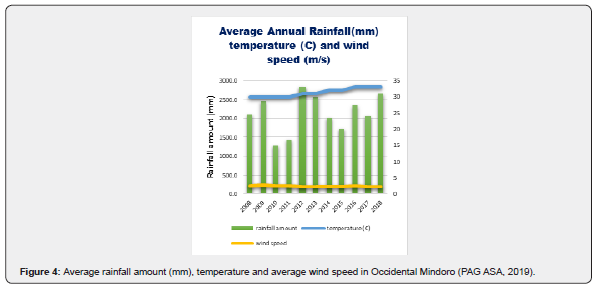
The figure shows that the average temperature in the province varies from 30 to 33°C from 2008. It also means that heat index in the province is becoming warmer. While average wind speed ranges from 2.5 to 5m/s. The rainfall pattern from 2008 to 2018 varies significantly. This may be attributed to the erratic changes in the weather pattern in the province. With the increasing temperature and minimum speed, the rate of evaporation is estimated to increase.
Moreover, the annual meteorological data obtained were used to determine the average annual evaporation rate. Minimum evaporation rate is during the month when the cloud cover is high and average wind velocity is near the annual minimum. While, maximum evaporation rate is during the dry season covering the month of March to May when the temperature is high, skies are clear and wind speed is high. Occidental Mindoro experiences high temperature or dry season during the month of November to April with high relative humidity and rainy seasons during the month of May to October.
Pennman equation of evaporation rate is used in this study to obtain the average annual evaporation rate in the province and it is then compared against the salt production rate. Data from including the wind speed, humidity and temperature were simulated using numerical solution. Figure 5 shows the annual evaporation rate against the production rate of salt industry in the province from 2008-2017.
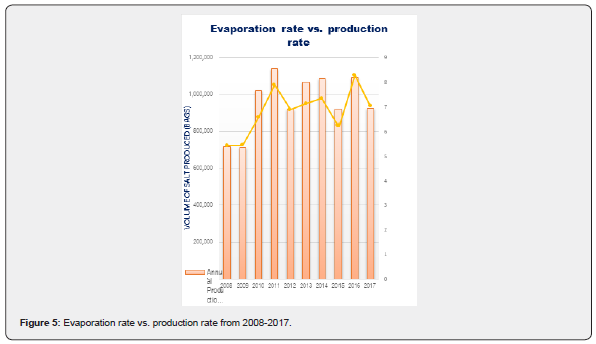
The table shows a significant relationship of evaporation rate in the salt production in the province. It can be observed when the evaporation is high, the production rate is also high. With the climatic characteristics obtained including the mean sea level height, temperature, wind speed, humidity, and pressure were simulated to estimate the evaporation rate. The results of the simulation shows that when temperature is high, and the wind speed is minimum, relative humidity is low, the resulting evaporation rate is high.
Furthermore, the same analysis was obtained when the meteorological data obtained from the three sites were simulated to determine the recent evaporation rate and its significant impact on production rate from January to May, 2019. Table 2 shows the same behavior of the estimated evaporation rate.

The table significantly shows the variation of evaporation rates in the three sites. The simulation also proved that evaporation rates are high during the dry months with maximum values during April and May as minimum wind speed is also observed
The behavior of evaporation in Laste differs in Toong, it is because the wind blows directly coming from the coast in Toong. Laste, although small in distance with the coastline, is surrounded by mangroves that block the wind to directly hit the salt beds. Further, Barrio Site is situated in the inner part of the Labangan Poblacion surrounded by almost residential and commercial structures. Evaporation rate play an important factor in salt production. Temperature, relative humidity, wind velocity, atmospheric pressure can speed up or slows down the evaporation rate.
Conclusion
This study presented the processes in the solar salt production existing in the province of Occidental Mindoro. Salt farms are designed considering the ecological characteristics and the prevailing climatic patterns in the salt farms. The solar salt production in the province is consist of reservoir, condenser and crystallizer. Ninety percent (90%) of the total land area is consider as evaporation ponds and the 10% as the crystallization pond where the salt is harvested.
Salt harvested in the province is either bought by traders, other buyers and TAMACO and being sold or transported locally and outside the province. Price of salt per bags varies significantly on the volume of salt produced, dry and off-season and lack of policy on fixed price per bags affecting the small scale salt farmers.
Results of the simulations show that evaporation rate is mainly dependent on the temperature, rainfall amount, humidity, wind speed, atmospheric pressure and elevation. The study revealed that high temperature, minimum wind speed, lower humidity and less rainfall amount can speed up the evaporation rate. Moreover, evaporation rate has significant impact on the salt production. Higher evaporation rate can speed up the crystallization process, thus more salt can be produced.
Considering other methods in estimating the evaporation rate can be used in the study to further proved the analysis obtained. Investigation on the engineering factors as to the efficient and effective area for salt beds should be done to provide a basis on optimizing the salt production processes. Moreover, a least-cost analysis should be done to investigate the benefits of introducing technology-based equipment in the different stages of the salt production
Acknowledgement
The author would like to thanks the Tamaraw Salt Cooperative (TAMACO) and JALD Incorporated for the data used in this study, and DOST: PAG-ASA for the meteorological data used in the simulation.
References
- Affam M, Asamoah DN (2011) Economic Potential of Salt Mining in Ghana Towards the Oil Find. Research Journal of Environmental and Earth Sciences 3(5): 448-456
- Hossain MS, Hossain ZM, Rahman CS (2006) An Analysis of Economic and Environmental Issues Associated with Sea Salt Production in Bangladesh and Thailand Cost. International Journal of ecology and Environmental Science 32: 159-172
- Sedivy VM (2009) Environmental Balance of Salt Production Speaks in favor of Solar Saltworks. Global Nest Journal 11(1): 41-48.
- Acedo CE, Hontucan RM (2017) PH Salt Industry Reeling from Climate Change. Conference of the Philippines Population Association.
- Business Mirror (2017) Occidental Midnoro boosting salt industry through new technology.
- Department of Trade and Industry (2018) Salt Industry Roadmap 2017-2022.
- PhilAtlas (2019) Magsaysay, Occidental Mindoro.
- PhilAtlas (2019) San Jose, Occidental Mindoro.
- Akridge GD (2008) Methods for calculating brine evaporation rates during salt production. Journal of Archaeological Science 35(6): 1453-1462.
- Penman HL (1948) Natural evaporation from open water, bare soil, and grass. Proceedings of the Royal Society Series A 193(1032): 120e145.
- Tamaraw Salt Producers of Occidental Mindoro (2019) Conditions of salt farms in the province of occidental Mindoro.






























